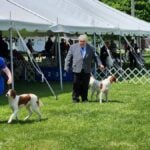
Home » Profiles in Curls | Barbet Proportion and Presentation

The body of a Barbet must be both substantial and athletic, exhibiting no exaggeration. The unique silhouette of this medium-sized breed is slightly rectangular with a strong, broad, proportionally large head, and a long, sweeping tail. Covered with dense, curly hair and a distinctive beard, the Barbet is unmistakably a Sporting dog constructed for power and agility as he flushes and retrieves waterfowl and upland game in any sort of weather.
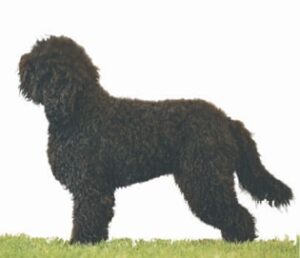
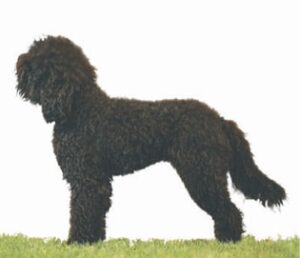
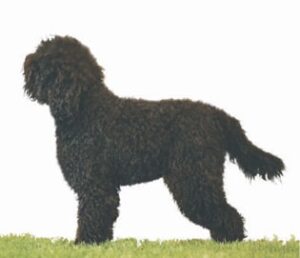
A strong neck, blending well into the shoulder; a broad, deep chest; long, rounded rib cage; and a short, flexible, slightly arched loin are all characteristics of the most robust of canine athletes. The underline is slightly inclined, without tuck-up. The tail is the natural extension of the topline, long and low-set. While exact proportion is not as important as balance, a longer dog is much preferred over a short-backed or square dog that must surely lack durability in undergrowth and marshy terrain.

Images A, B, and C have been adjusted to represent variations in profile to help illustrate the language of our AKC Standard. Visualizing the intent of the words helps to train the eye to focus on the best exhibits—those which most closely represent the intent of the standard.
The coat of the Barbet is his defining characteristic. The hair on the top of the head reaches the bridge of the nose. Ears are covered in long hair. Profuse hair covers the whole body evenly with thick, natural curls. A wide variation in curl is acceptable; from wavy, to large and loose curls, to tight, smaller curls. Regardless, the hair must retain enough loft to protect from weather and underbrush. A straight, flat or sparse coat is incorrect.
The coat is shown in as natural a state as possible; clean and free from mats. The hair is to retain curl.
Barbet coat is shown in as natural a state as possible; clean and free from mats. The hair is to retain curl. While scissoring is necessary to keep him neat, excessive sculpting and shaping is to be penalized. Likewise, poorly turned out animals (clipped, matted or unkempt) should be penalized. Animals with sparse hair, bare patches, or the impression of ill health or poor management must not be considered for points. Tightly curled dogs can give the impression of more substance and can appear to be more sculpted.
Viewpoint
As an exhibitor and breed mentor, I’ll offer some opinions that I am arriving at regarding my preferred ring presentation. As varied as the curl might be on our dogs, so is the opinion of breeders/exhibitors on trimming. There are those who believe the dogs should never be trimmed, and there are those who are more comfortable with a neater appearance. There is no final authority on this topic, and our standard only addresses excesses in one direction or another.
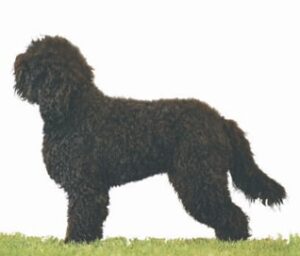
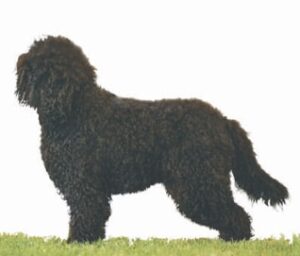
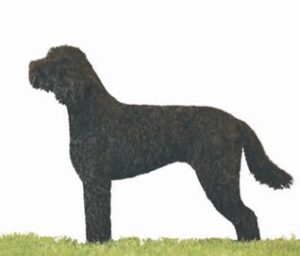
I believe a successful trim “outlines” and reveals the shape of the body, without being extreme. An unsuccessful trim obscures the natural shape of the body. Each animal must be neatened to one degree or another, but the coat must be presented long enough to sufficiently assess its quality. As a newly recognized breed, we bring to competition many novice exhibitors or folks who are new to the breed—some wielding scissors for the first time and some relying upon professional groomers as they aren’t yet sure of their scissor skills. A trained eye is the best grooming tool!
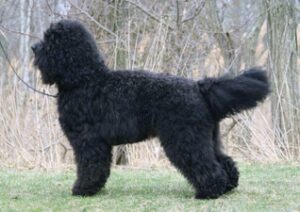
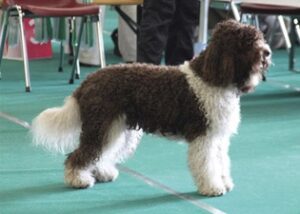
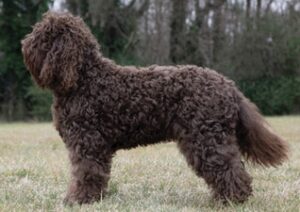
Images E, F, and G have again been adjusted to represent variations in profile to help illustrate the words of our AKC Standard. Visualizing the intent of the words helps to train the eye to focus on preparing exhibits that most closely represent the intent of the standard. Make note that this is the same image we used to illustrate a correct profile. The only thing that has changed is the hair.
As fellow exhibitors and judges, we must rely upon our standard for direction, train our own eye to see each dog’s virtues and shortfalls, and present the breed (or judge it) to the best of our ability. Images H, I, and J illustrate a healthy variation of coat curl and presentation, while retaining the called-for profile of this rare and fascinating breed.